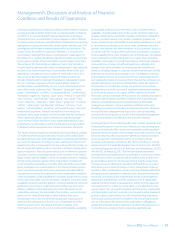Walmart 2013 Annual Report Download - page 39
Download and view the complete annual report
Please find page 39 of the 2013 Walmart annual report below. You can navigate through the pages in the report by either clicking on the pages listed below, or by using the keyword search tool below to find specific information within the annual report.
Walmart 2013 Annual Report || 37
Property and Equipment
Property and equipment are stated at cost. Gains or losses on disposition
are recognized as earned or incurred. Costs of major improvements are
capitalized, while costs of normal repairs and maintenance are charged
to expense as incurred. The following table summarizes the Company’s
property and equipment balances and includes the estimated useful lives
that are generally used to depreciate the assets on a straight-line basis:
Fiscal Years Ended
Estimated January 31,
(Amounts in millions) Useful Lives 2013 2012
Land N/A $ 25,612 $ 23,499
Buildings and improvements 3–40 years 90,686 84,275
Fixtures and equipment 3–25 years 40,903 39,234
Transportation equipment 3–15 years 2,796 2,682
Construction in progress N/A 5,828 5,312
Property and equipment $165,825 $155,002
Accumulated depreciation (51,896) (45,399)
Property and equipment, net $113,929 $109,603
Leasehold improvements are depreciated over the shorter of the
estimated useful life of the asset or the remaining expected lease term.
Depreciation expense for property and equipment, including amor-
tization of property under capital leases, for scal 2013, 2012 and 2011
was $8.4 billion, $8.1 billion and $7.6 billion, respectively. Interest costs
capitalized on construction projects were $74 million, $60 million and
$63 million in scal 2013, 2012 and 2011, respectively.
Long-Lived Assets
Long-lived assets are stated at cost. Management reviews long-lived assets
for indicators of impairment whenever events or changes in circumstances
indicate that the carrying amount may not be recoverable. The evaluation
is performed at the lowest level of identi able cash ows, which is at the
individual store or club level or, in certain circumstances, a market group
of stores. Undiscounted cash ows expected to be generated by the
related assets are estimated over the assets’ useful lives based on updated
projections. If the evaluation indicates that the carrying amount of the
assets may not be recoverable, any potential impairment is measured
based upon the fair value of the related asset or asset group as determined
by an appropriate market appraisal or other valuation technique.
Impairment charges of long-lived assets for scal 2013, 2012 and 2011
were not signi cant.
Goodwill and Other Acquired Intangible Assets
Goodwill represents the excess of the purchase price over the fair value
of net assets acquired in business combinations and is allocated to the
appropriate reporting unit when acquired. Other acquired intangible
assets are stated at the fair value acquired as determined by a valuation
technique commensurate with the intended use of the related asset.
Goodwill and inde nite-lived intangible assets are not amortized; rather,
they are evaluated for impairment annually and whenever events or
changes in circumstances indicate that the value of the asset may be
impaired. De nite-lived intangible assets are considered long-lived
assets and are amortized on a straight-line basis over the periods that
expected economic bene ts will be provided.
Goodwill is evaluated for impairment using either a qualitative or
quantitative approach for each of the Company’s reporting units.
Generally, a qualitative assessment is rst performed to determine
whether a quantitative goodwill impairment test is necessary. If
man agement determines, after performing an assessment based on
the qualitative factors, that the fair value of the reporting unit is more
likely than not less than the carrying amount, or that a fair value of the
reporting unit substantially in excess of the carrying amount cannot
be assured, then a quantitative goodwill impairment test would be
required. The quantitative test for goodwill impairment is performed
by determining the fair value of the related reporting units. Fair value
is measured based on the discounted cash ow method and relative
market-based approaches.
For the reporting units that were tested using only the qualitative
assessment, management determined that the fair value of each
reporting unit is more likely than not greater than the carrying amount
and, as a result, quantitative analyses were not required. For the reporting
units tested using a quantitative impairment test, management
determined the fair value of each reporting unit is greater than the
carrying amount. Accordingly, the Company has not recorded any
impairment charges related to goodwill.
The following table re ects goodwill activity, by reportable segment,
for scal 2013 and 2012:
Walmart
(Amounts in millions) Walmart U.S. International Sam’s Club Total
Balances as of
February 1, 2011 $239 $16,211 $313 $16,763
Changes in currency
translation and other — (535) — (535)
Acquisitions
(1)
200 4,223 — 4,423
Balances as of
January 31, 2012 439 19,899 313 20,651
Changes in currency
translation and other — (65) — (65)
Purchase accounting
adjustments for
prior scal year
acquisitions
(2)
4 (532) — (528)
Acquisitions
(3)
— 439 — 439
Balances as of
January 31, 2013 $443 $19,741 $313 $20,497
(1) Goodwill recorded for acquisitions in fi scal 2012 primarily relates to the acquisition
of 147 Netto stores from Dansk Supermarked in the United Kingdom and to the
acquisition of a 51% ownership in Massmart, a retailer based in South Africa.
Refer to Note 13 for more information about these acquisitions.
(2) Fiscal 2013 purchase accounting adjustments primarily relate to the fi nalization of
the Massmart purchase price allocation, which was preliminary at January 31, 2012.
(3) Goodwill recorded for fi scal 2013 acquisitions relates to several acquisitions
completed in fi scal 2013 that are not signifi cant, individually or in the aggregate,
to the Company’s Consolidated Financial Statements.
Notes to Consolidated Financial Statements
























